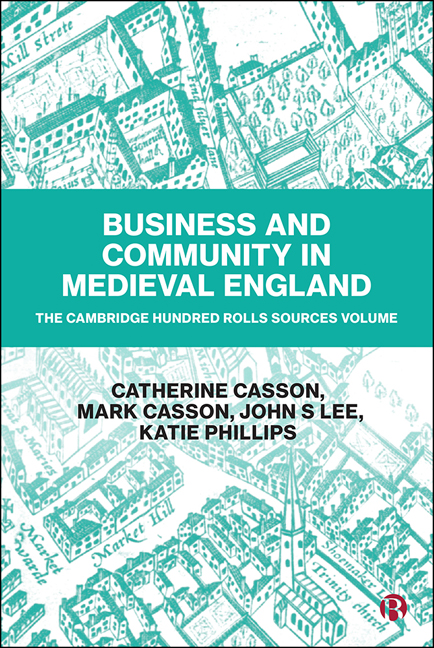Book contents
- Frontmatter
- Contents
- Abbreviations
- Notes on the Authors
- Introduction
- The Cambridge Hundred Rolls
- Appendix 1 Amercements in Cambridge 1176–7: List of People, Many From Cambridge, Who Were Amerced For Carrying Corn by Water Without a Licence
- Appendix 2 Cambridge Tallage of 1211: Analysis of Payments 1211–25
- Appendix 3 Amercements of the Abbot of Ramsey and William De Kantilup and Their Associates in Cambridge in 1219
- Appendix 4 Gifts (Oblata), Representing Fines For Offences Made By Cambridge People in 1221
- Appendix 5 Summary of Information in Published Editions of the Pipe Rolls Relating to People and Places in Cambridge, 1130, 1158–1224, 1230 and 1242
- Appendix 6 Selected Excerpts From Rotuli Curiae Regis I–XX, Relating to People and Places in Cambridge
- Appendix 7 Selected Excerpts From Calendar of Fine Rolls I–III, Relating to People and Places in Cambridge
- Appendix 8 Cambridge Debts: Selected Cases From the Exchequer of the Jews, 1219–81
- Appendix 9 Cambridge: Jewish Records of Debts by People Resident in Or Closely Connected to Cambridge
- Appendix 10 Feet of Fines: Selected Cases Relevant to the Town of Cambridge
- Appendix 11 Cambridgeshire Subsidy Rolls and Eyres
- Appendix 12 Mayors and Bailiffs of Cambridge, 1263–1300, as Listed by the Antiquary William Cole
- Appendix 13 Ancient Places in Cambridge
- Appendix 14 Family Dynasties of Property Owners
- References
- Index
Appendix 14 - Family Dynasties of Property Owners
Published online by Cambridge University Press: 18 March 2021
- Frontmatter
- Contents
- Abbreviations
- Notes on the Authors
- Introduction
- The Cambridge Hundred Rolls
- Appendix 1 Amercements in Cambridge 1176–7: List of People, Many From Cambridge, Who Were Amerced For Carrying Corn by Water Without a Licence
- Appendix 2 Cambridge Tallage of 1211: Analysis of Payments 1211–25
- Appendix 3 Amercements of the Abbot of Ramsey and William De Kantilup and Their Associates in Cambridge in 1219
- Appendix 4 Gifts (Oblata), Representing Fines For Offences Made By Cambridge People in 1221
- Appendix 5 Summary of Information in Published Editions of the Pipe Rolls Relating to People and Places in Cambridge, 1130, 1158–1224, 1230 and 1242
- Appendix 6 Selected Excerpts From Rotuli Curiae Regis I–XX, Relating to People and Places in Cambridge
- Appendix 7 Selected Excerpts From Calendar of Fine Rolls I–III, Relating to People and Places in Cambridge
- Appendix 8 Cambridge Debts: Selected Cases From the Exchequer of the Jews, 1219–81
- Appendix 9 Cambridge: Jewish Records of Debts by People Resident in Or Closely Connected to Cambridge
- Appendix 10 Feet of Fines: Selected Cases Relevant to the Town of Cambridge
- Appendix 11 Cambridgeshire Subsidy Rolls and Eyres
- Appendix 12 Mayors and Bailiffs of Cambridge, 1263–1300, as Listed by the Antiquary William Cole
- Appendix 13 Ancient Places in Cambridge
- Appendix 14 Family Dynasties of Property Owners
- References
- Index
Summary
Medium-size families
The Bateman family
The driving forces in the Bateman family were the two Richards, father and son. Their reputation was such that both were jurors for the Hundred Rolls. The first recorded member of the family is Selede, who had two sons, Eustace and John. John had at least five sons: Richard senior, Geoffrey, Gilbert of Hardleston, John Tws and Wade. Three of the five sons had different surnames, whilst the other two had no surname at all. Richard senior had a son Richard junior, his heir. In 1279 they both held significant amounts of property.
Richard senior converted to Judaism. It is possible that other sons of John Selede converted too and adopted new names. Richard received a reward for his conversion from Barnwell Priory. In return he gave the Priory two fees worth 12s per annum. Richard (probably senior) also gave 4s annual rent to Anglesey Priory.
Both father and son acquired significant property portfolios through purchase. Richard senior's portfolio was centred around the market: it comprised a messuage in St Mary's which he bought from Adam of Lincoln; two shops in the Butchery bought from Richard Burs; and some vacant land in St Mary’s, also bought from Richard Burs. He also inherited a shop in St Edward's from his father. In 1295 Robert junior was paying 4s. rent on a shop in the Butchery to Barnwell priory. It may be Richard senior who in c.1274 purchased from St Radegund's Priory a messuage formerly of William Novacurt (an aristocrat) in return for rents on various properties, namely a messuage in St Botolph's near the King's Ditch by Trumpington Gate and three shops in Pyron Lane, running from Trumpington Street towards Milne Street.
Richard junior purchased a messuage in St Mary's bought from Humphrey of Clopton and Juliana his wife; four shops in St Mary's from Thomas of Cottenham; three shops in St Michael's and a messuage in St Edwards from Anglesey Priory, which they had been given by Richard Hubert; 3.5 acres in the Cambridge fields bought from John But; and 0.5 acres in the same fields bought from John above the market.
- Type
- Chapter
- Information
- Business and Community in Medieval EnglandThe Cambridge Hundred Rolls Source Volume, pp. 343 - 364Publisher: Bristol University PressPrint publication year: 2020



